Happily N'Ever After
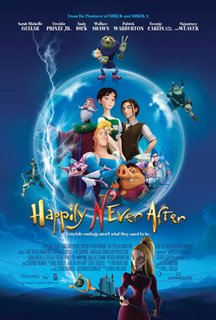 According to the press notes for Happily N'Ever After, the film's entire production time from start to finish was 15 months, a record for an animated film. Given the final product that is playing on screens, I don't know if that would be something I'd be bragging about. Happily N'Ever After is yet another entry in the ever-growing number of "fairy tale spoof" computer animated films. The short amount of time the filmmakers spent on this thing definitely shows, due to the uninspired animation and character designs, the weak jokes, and the dull storytelling. It's a shame too, because the movie has a lot of good ideas that never get fully explored or even touched upon. If first-time director Paul J. Bolger had just spent some actual time on this thing, he might have been on to something.
According to the press notes for Happily N'Ever After, the film's entire production time from start to finish was 15 months, a record for an animated film. Given the final product that is playing on screens, I don't know if that would be something I'd be bragging about. Happily N'Ever After is yet another entry in the ever-growing number of "fairy tale spoof" computer animated films. The short amount of time the filmmakers spent on this thing definitely shows, due to the uninspired animation and character designs, the weak jokes, and the dull storytelling. It's a shame too, because the movie has a lot of good ideas that never get fully explored or even touched upon. If first-time director Paul J. Bolger had just spent some actual time on this thing, he might have been on to something.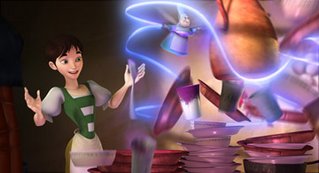 The story is set in a mystical world of fairy tales that is ruled over by a gentle and all-seeing Wizard (voice by George Carlin). It is the Wizard's job to make sure that all the fairy tales play out the way they're supposed to. Apparently, in this world, the classic stories the characters are stuck in repeat in a continuous loop. Once the happy ending is achieved, the whole thing starts all over again. The Wizard keeps everything in balance with an all-seeing crystal ball monitor, and a magical scale that keeps the "good" and "evil" element in the fairy tales in balance. As the film opens, the Wizard has decided to take a vacation to Scotland to participate in a golf tournament, and leaves his two animal assistants, Mambo the cat (Andy Dick) and Munk the pig (Wallace Shawn), in charge of keeping things in order while he is gone. Poor Mambo is bored with how the fairy tale stories always end up the same way, and wishes that something exciting would happen to shake things up a bit. Little does the smart-mouthed feline realize he's about to get his wish, and then some.
The story is set in a mystical world of fairy tales that is ruled over by a gentle and all-seeing Wizard (voice by George Carlin). It is the Wizard's job to make sure that all the fairy tales play out the way they're supposed to. Apparently, in this world, the classic stories the characters are stuck in repeat in a continuous loop. Once the happy ending is achieved, the whole thing starts all over again. The Wizard keeps everything in balance with an all-seeing crystal ball monitor, and a magical scale that keeps the "good" and "evil" element in the fairy tales in balance. As the film opens, the Wizard has decided to take a vacation to Scotland to participate in a golf tournament, and leaves his two animal assistants, Mambo the cat (Andy Dick) and Munk the pig (Wallace Shawn), in charge of keeping things in order while he is gone. Poor Mambo is bored with how the fairy tale stories always end up the same way, and wishes that something exciting would happen to shake things up a bit. Little does the smart-mouthed feline realize he's about to get his wish, and then some.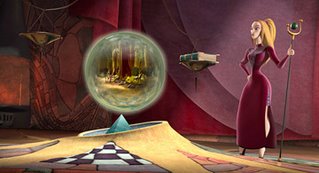 Meanwhile, in the story of Cinderella, everything is going as is expected. Poor, put upon Ella (Sarah Michelle Gellar) is frequently verbally abused by her evil stepmother Frieda (Sigourney Weaver) and two wicked stepsisters. Ella wishes to go to the Royal Ball, and win the heart of the handsome and charming, yet dim-witted and arrogant Prince Humperdink (Patrick Warburton), little realizing that someone else already loves her, that person being the Prince's lowly servant boy Rick (Freddie Prinze, Jr). Ella gets to attend the ball thanks to the magic of her Fairy Godmother (Lisa Kaplan), gets the attention of the Prince, and everything seems to be going as it should. That is until evil stepmother Frieda happens to stumble upon the Wizard's chamber and discovers the secrets of his magic scepter that can change the course of all the stories in Fairy Tale Land. She easily overtakes Mambo and Munk, steals the scepter, and ushers in a new era where the villains win at the end of the story, and happy endings are no more. Rounding up an army of trolls, wolves, and monsters, Frieda seems destined to be the new ruler of the land, unless Ella, Rick, and the animal sidekicks can set things right once again before the Wizard comes home from vacation.
Meanwhile, in the story of Cinderella, everything is going as is expected. Poor, put upon Ella (Sarah Michelle Gellar) is frequently verbally abused by her evil stepmother Frieda (Sigourney Weaver) and two wicked stepsisters. Ella wishes to go to the Royal Ball, and win the heart of the handsome and charming, yet dim-witted and arrogant Prince Humperdink (Patrick Warburton), little realizing that someone else already loves her, that person being the Prince's lowly servant boy Rick (Freddie Prinze, Jr). Ella gets to attend the ball thanks to the magic of her Fairy Godmother (Lisa Kaplan), gets the attention of the Prince, and everything seems to be going as it should. That is until evil stepmother Frieda happens to stumble upon the Wizard's chamber and discovers the secrets of his magic scepter that can change the course of all the stories in Fairy Tale Land. She easily overtakes Mambo and Munk, steals the scepter, and ushers in a new era where the villains win at the end of the story, and happy endings are no more. Rounding up an army of trolls, wolves, and monsters, Frieda seems destined to be the new ruler of the land, unless Ella, Rick, and the animal sidekicks can set things right once again before the Wizard comes home from vacation.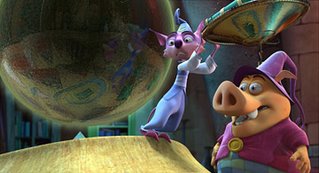 Happily N'Ever After carries a creative plot that screams out for clever ideas and a lot of fun, but sadly offers very little if anything. I was intrigued and interested in many of its ideas, but the movie never slows down enough for us to admire them. Take the whole fairy tale characters living in a continuous loop thing. The idea of them being forced to relive the same story over and over instantly brought back memories of the classic Bill Murray comedy, Groundhog's Day, and I started to imagine what a clever screenplay could do with this idea, especially in an animated film where anything is possible. Do the characters know they are stuck in a continuous loop, or are their memories somehow erased when the story starts over again? Do they ever get tired of reliving the same story over and over? Have they, like Mambo the cat, ever wished to shake things up and change things a little? Sadly, the screenplay by Robert Moreland doesn't even bother to touch upon these potentially interesting questions. It instead decides to parade out a series of uninspired rapid-fire gags that were hard pressed to bring forth more than a polite giggle from an audience nearly full of young children and their parents. Even the idea of Frieda the stepmother altering the Wizard's magical scale so that evil can overpower good is wasted. We get a couple barely amusing sight gags of stories like Rumplestiltskin and Little Red Riding Hood ending differently than they should, and then the movie moves on. We see so much potential wasted up there on the screen that it almost becomes hard to concentrate on the film itself. Most likely, since there is very little on the screen to engage and entertain, the audience is left to entertain itself and think of these ideas being used in a better way and in a better movie.
Happily N'Ever After carries a creative plot that screams out for clever ideas and a lot of fun, but sadly offers very little if anything. I was intrigued and interested in many of its ideas, but the movie never slows down enough for us to admire them. Take the whole fairy tale characters living in a continuous loop thing. The idea of them being forced to relive the same story over and over instantly brought back memories of the classic Bill Murray comedy, Groundhog's Day, and I started to imagine what a clever screenplay could do with this idea, especially in an animated film where anything is possible. Do the characters know they are stuck in a continuous loop, or are their memories somehow erased when the story starts over again? Do they ever get tired of reliving the same story over and over? Have they, like Mambo the cat, ever wished to shake things up and change things a little? Sadly, the screenplay by Robert Moreland doesn't even bother to touch upon these potentially interesting questions. It instead decides to parade out a series of uninspired rapid-fire gags that were hard pressed to bring forth more than a polite giggle from an audience nearly full of young children and their parents. Even the idea of Frieda the stepmother altering the Wizard's magical scale so that evil can overpower good is wasted. We get a couple barely amusing sight gags of stories like Rumplestiltskin and Little Red Riding Hood ending differently than they should, and then the movie moves on. We see so much potential wasted up there on the screen that it almost becomes hard to concentrate on the film itself. Most likely, since there is very little on the screen to engage and entertain, the audience is left to entertain itself and think of these ideas being used in a better way and in a better movie.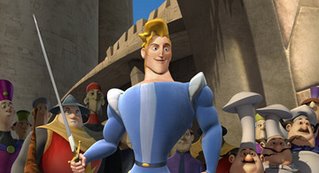 The characters suffer almost as much as the story, since they almost seem to be completely deprived of anything resembling personality. Ella is as colorless and bland as a fairy tale heroine has ever been, and the same goes for her secret love interest Rick. The comic relief animal sidekicks are more annoying than funny, and seldom have anything funny to say other than to scream and argue with each other. The only character who generates any kind of spark is the evil Frieda, and that's because the filmmakers have let Sigourney Weaver go all out, and just have a blast completely reveling in her over the top villain role. She's the only one in this movie who seems to be having any fun, and it's a shame they couldn't give her some better one-liners to go along with her energetic and enthusiastic performance. The supporting villains are a sorry and underdeveloped lot of generic fantasy monsters who literally do nothing but sit around in the castle and party to music all day. To further add to the film's long list of problems, the film's look is completely generic and as uninspired as can be. Everyone has this overly plastic look to their skin that makes them look more like living dolls than real people. Hair barely moves, and almost looks like it's been painted on top of their heads like a Ken doll or something. The character movements are limited, and the overall design and look of the movie would barely pass inspection on a Saturday morning cartoon. Seeing it blown up on the big screen only makes it worse. A movie like this calls for an imaginative look and art style, and all we get are some generic backdrops and designs that look like they were ripped right out of some hack artist's sketchbook.
The characters suffer almost as much as the story, since they almost seem to be completely deprived of anything resembling personality. Ella is as colorless and bland as a fairy tale heroine has ever been, and the same goes for her secret love interest Rick. The comic relief animal sidekicks are more annoying than funny, and seldom have anything funny to say other than to scream and argue with each other. The only character who generates any kind of spark is the evil Frieda, and that's because the filmmakers have let Sigourney Weaver go all out, and just have a blast completely reveling in her over the top villain role. She's the only one in this movie who seems to be having any fun, and it's a shame they couldn't give her some better one-liners to go along with her energetic and enthusiastic performance. The supporting villains are a sorry and underdeveloped lot of generic fantasy monsters who literally do nothing but sit around in the castle and party to music all day. To further add to the film's long list of problems, the film's look is completely generic and as uninspired as can be. Everyone has this overly plastic look to their skin that makes them look more like living dolls than real people. Hair barely moves, and almost looks like it's been painted on top of their heads like a Ken doll or something. The character movements are limited, and the overall design and look of the movie would barely pass inspection on a Saturday morning cartoon. Seeing it blown up on the big screen only makes it worse. A movie like this calls for an imaginative look and art style, and all we get are some generic backdrops and designs that look like they were ripped right out of some hack artist's sketchbook.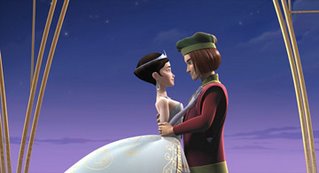 There's a very good reason why most animated films take years to complete. The filmmakers spend the time fine tuning the script and the jokes and the story so that when it is released, it is hopefully as good as it can be. Happily N'Ever After is like watching a first draft of an animated movie. The ideas and concepts are there, but the characters need to be fleshed out more, and the jokes need to be funnier. Everything about this movie fails to impress, and if it were not for some of the big names it managed to attract to its cast, I find it doubtful this would cut it in the straight to video market. There are a lot of good reasons why an animated film should never be rushed to completion. Happily N'Ever After is proof positive of a lot of those reasons.
There's a very good reason why most animated films take years to complete. The filmmakers spend the time fine tuning the script and the jokes and the story so that when it is released, it is hopefully as good as it can be. Happily N'Ever After is like watching a first draft of an animated movie. The ideas and concepts are there, but the characters need to be fleshed out more, and the jokes need to be funnier. Everything about this movie fails to impress, and if it were not for some of the big names it managed to attract to its cast, I find it doubtful this would cut it in the straight to video market. There are a lot of good reasons why an animated film should never be rushed to completion. Happily N'Ever After is proof positive of a lot of those reasons.No Amazon listing to be found...sorry.






0 Comments:
Post a Comment
<< Home